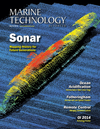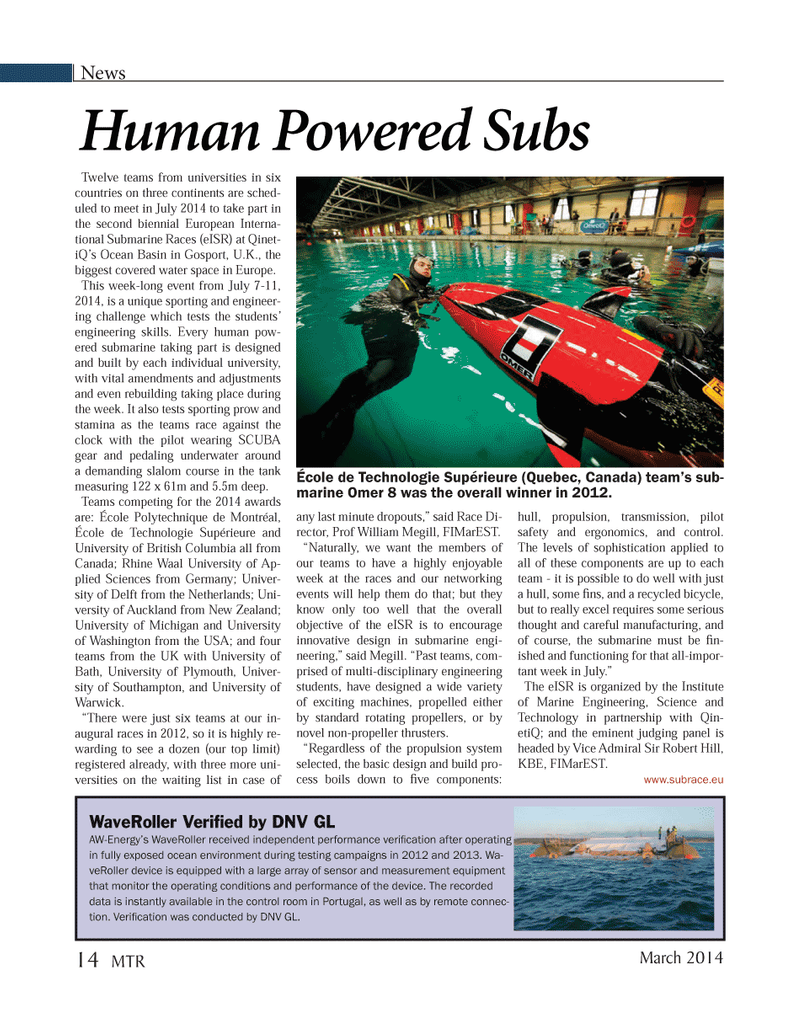
Page 14: of Marine Technology Magazine (March 2014)
Instrumentation: Measurement, Process & Analysis
Read this page in Pdf, Flash or Html5 edition of March 2014 Marine Technology Magazine
Twelve teams from universities in six countries on three continents are sched-uled to meet in July 2014 to take part in the second biennial European Interna-tional Submarine Races (eISR) at Qinet-iQ?s Ocean Basin in Gosport, U.K., the biggest covered water space in Europe. This week-long event from July 7-11, 2014, is a unique sporting and engineer- ing challenge which tests the students? engineering skills. Every human pow- ered submarine taking part is designed and built by each individual university, with vital amendments and adjustments and even rebuilding taking place during the week. It also tests sporting prow and stamina as the teams race against the clock with the pilot wearing SCUBA gear and pedaling underwater around a demanding slalom course in the tank measuring 122 x 61m and 5.5m deep.Teams competing for the 2014 awards are: École Polytechnique de Montréal, École de Technologie Supérieure and University of British Columbia all from Canada; Rhine Waal University of Ap- plied Sciences from Germany; Univer- sity of Delft from the Netherlands; Uni-versity of Auckland from New Zealand; University of Michigan and University of Washington from the USA; and four teams from the UK with University of Bath, University of Plymouth, Univer- sity of Southampton, and University of Warwick. ?There were just six teams at our in-augural races in 2012, so it is highly re-warding to see a dozen (our top limit) registered already, with three more uni- versities on the waiting list in case of any last minute dropouts,? said Race Di- rector, Prof William Megill, FIMarEST. ?Naturally, we want the members of our teams to have a highly enjoyable week at the races and our networking events will help them do that; but they know only too well that the overall objective of the eISR is to encourage innovative design in submarine engi- neering,? said Megill. ?Past teams, com- prised of multi-disciplinary engineering students, have designed a wide variety of exciting machines, propelled either by standard rotating propellers, or by novel non-propeller thrusters. ?Regardless of the propulsion system selected, the basic design and build pro- cess boils down to ve components: hull, propulsion, transmission, pilot safety and ergonomics, and control. The levels of sophistication applied to all of these components are up to each team - it is possible to do well with just a hull, some ns, and a recycled bicycle, but to really excel requires some serious thought and careful manufacturing, and of course, the submarine must be n-ished and functioning for that all-impor- tant week in July.? The eISR is organized by the Institute of Marine Engineering, Science and Technology in partnership with Qin- etiQ; and the eminent judging panel is headed by Vice Admiral Sir Robert Hill, KBE, FIMarEST. www.subrace.eu News Human Powered Subs École de Technologie Supérieure (Quebec, Canada) team?s sub- marine Omer 8 was the overall winner in 2012. WaveRoller VeriÞ ed by DNV GL AW-Energy?s WaveRoller received independent performance veri Þ cation after operating in fully exposed ocean environment during testing campaigns in 2012 and 2013. Wa- veRoller device is equipped with a large array of sensor and measurement equipment that monitor the operating conditions and performance of the device. The recorded data is instantly available in the control room in Portugal, as well as by remote connec- tion. Veri Þ cation was conducted by DNV GL. March 2014 14 MTRMTR #2 (1-17).indd 14MTR #2 (1-17).indd 142/24/2014 10:07:43 AM2/24/2014 10:07:43 AM

 13
13

 15
15
